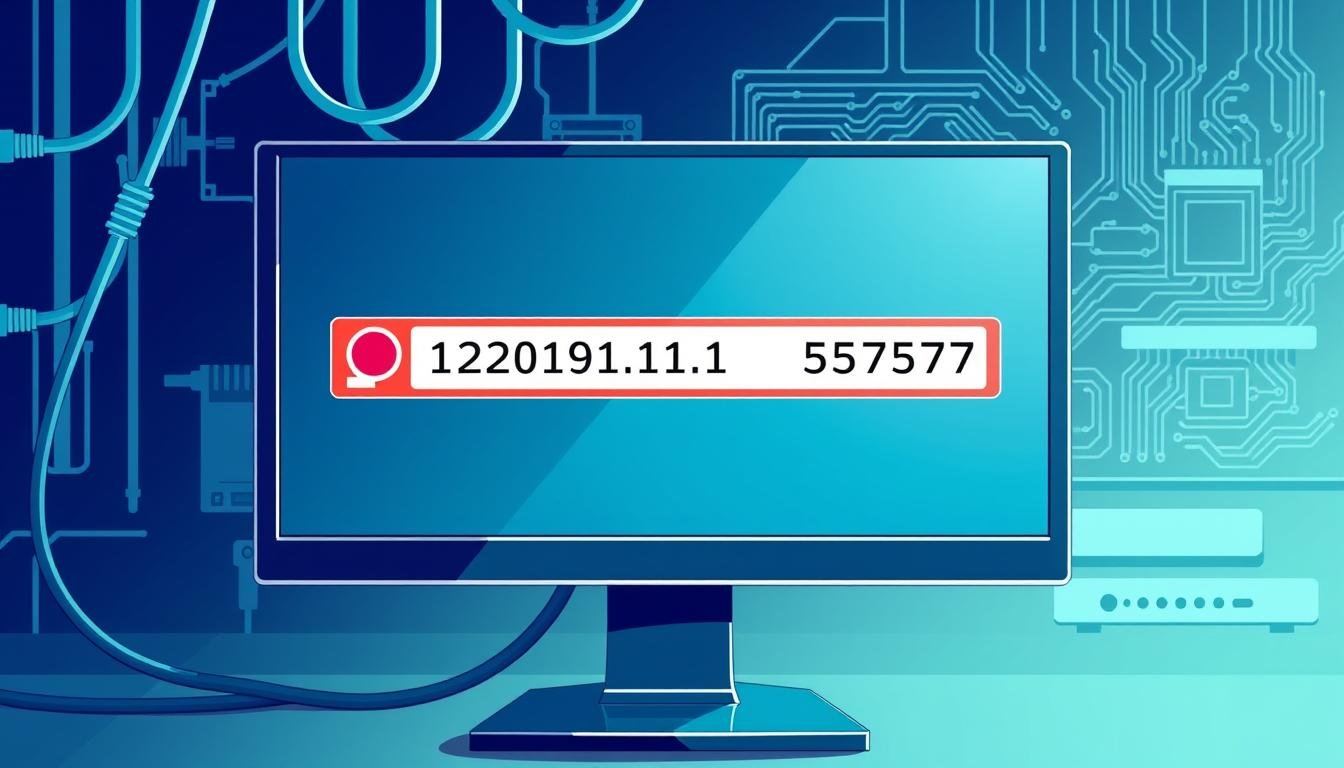This is a detailed, technical illustration of a computer network configuration focusing on localhost connections. It features visual elements like arrows connecting to a computer screen displaying code and network settings. The IP address 127.0.0.1 is prominently shown, alongside a graphical representation of port 57573, all set against a sleek, modern digital background.
Network setup can be tricky. But local connections like 127.0.0.1:57573 help apps talk on your computer.
This IP address is called localhost. It lets software chat within the same device.
Local port numbers are special channels on your computer. Port 57573 is where apps send and receive data.
Localhost setups help test and run software well. Network pros and coders use them often.
This guide will explain local network links. We’ll make tech talk easy to grasp.
Knowing localhost helps fix tech issues. It also makes your system work better.
We want to make complex network ideas clear for everyone.
What is 127.0.0.1 and its Significance?
127.0.0.1 is a special IP address called localhost. It lets a computer talk to itself to test and fix issues.
This address creates a direct path inside your computer. It’s like having a private chat with your device’s network systems.
Web developers use localhost to test websites before making them live. It helps find and fix problems early on.
Network experts use 127.0.0.1 to solve connection issues. They can test software without affecting other networks.
This address works the same on all computer systems. It’s a key tool for managing network talks on any device.
How Network Connections Work
Network connections use TCP/IP protocols for digital communication. These systems help devices talk across networks using IP addresses and port numbers.
Sockets are key in making network connections. They combine an IP address and port number for device communication.
Network protocols set rules for sending data packets. TCP/IP is the primary language for internet connections.
Devices use specific ports to share info through these protocols. Each port acts like a digital door for different network services.
Port 57573 might be used by one app to send data, which doesn’t interfere with other network traffic.
Knowing how these parts work helps create better communication channels. Ports, sockets, and protocols work together to ensure smooth data transfer.
Setting Up a Local Connection
This is a detailed illustration of a computer screen displaying a localhost network configuration window, featuring the IP address 127.0.0.1 and port number 57573. The scene includes visual elements like network cables, a router, and a circuit board layout in the background, emphasizing local connections in a tech-savvy environment. The colour palette is cool-toned with blues and greens, reflecting a modern digital aesthetic.
A smooth local connection needs careful network settings. Localhost setup begins with understanding your computer’s internal communication paths.
You can access network settings through the system control panel. Check the localhost setup to verify the correct port for your app.
Identify the 127.0.0.1:57573 address. Make sure it’s set up right for your network.
Firewall rules are key for local connections. Create exceptions for the ports you’re using.
Port forwarding helps route traffic to apps on your local machine. It’s vital for seamless app interactions.
Key steps for successful local connection setup include:
- Verify localhost address configuration
- Configure appropriate firewall exceptions
- Set up precise port forwarding rules
- Test connection stability
Advanced users need to tweak router settings. They may use command-line tools to fine-tune their network setup.
Always double-check your settings. This helps prevent communication issues between local apps.
Troubleshooting Connection Issues
Local network connections often bring up tricky error messages. Network diagnostics help fix these problems quickly.
Port 57573 issues usually come from a few common problems. Check if another app is using the same port.
Use Netstat to see what ports are being used. This can help find what’s blocking your connection.
“Connection refused” means a service isn’t listening on that port. This could be due to firewall settings or software issues.
Run network tests to find the exact problem. Check service status and firewall rules first.
Make sure no background tasks are messing with your network. Windows and Linux both have tools for network checks.
Try turning off security software if issues keep happening. Write down error messages to help tech support.
Security Considerations for Local Connections
Local connections need strong network security to fight cyber threats. Strong encryption is key to protecting sensitive data on local networks.
Access control is vital for network security. Strict user authentication helps limit vulnerabilities in the system.
Vulnerability tools find weak spots in network setup. This allows for better security management.
Regular security checks keep local connections safe. These checks spot risks and ensure access control works well.
Network managers should create firm security plans. These plans should include multi-factor login and top-notch encryption.
Experts stress the need to watch and update security often. Good vulnerability checks can stop network break-ins.
Companies must focus on network security. This protects their digital assets and keeps local systems safe.
Frequently Asked Questions
Many users find local network connections tricky. This guide helps you solve issues with localhost and port 57573.
Port connection problems often come from firewall settings or software conflicts. Network setup errors can also cause trouble with port 57573.
Checking app permissions and network settings can quickly fix these issues. Regular system updates also help keep your local network safe.
Local connections through 127.0.0.1 are usually secure with proper steps. To solve problems, check system logs and port availability.
For quick fixes, restart network services and check app settings. Look at system logs for error details.
If issues persist, contact your software vendor’s support team. A network pro can also help with challenging local problems.
FAQ
What exactly is the local port 127.0.0.1:57573?
Local port 127.0.0.1:57573 is a network endpoint on your computer. It helps apps talk to each other inside your machine.
Why would I need to use port 57573?
Apps uses port 57573 for tasks on your computer. It’s often used for testing and fixing software issues.
How is port 57573 currently in use?
You can use tools like Netstat on Windows or Linux on macOS. On Windows, open Command Prompt and type “netstat -ano | findstr:57573”.
What should I do if there’s a port conflict with 57573?
Change the port number in your app settings. Or, close the app using the port.
Use Task Manager to find and stop the conflicting process.
Is port 57573 a standard or reserved port?
Port 57573 is not standard. It’s usually assigned by apps for temporary use.
How can I secure local connections on port 57573?
Set up your firewall and use encryption when possible. Limit access to necessary apps and update your software often.
Keep an eye out for any strange access attempts.
Can I change the port number if needed?
Yes, most apps let you change the port number. To do so, check the app’s settings or manual.
What are common issues related to local port connections?
Common issues include port conflicts and firewall blocks. App connection problems and network setup errors can also happen.
How do I troubleshoot connection problems on port 57573?
Check if the app is running right. Look at firewall settings and network setup.
Use tools like Netstat and Ping to find and fix issues.
Is port 57573 safe to use?
Port 57573 is as safe as the apps using it. Download software from trusted sources and keep your system updated.
you may also read : Apple Teleport: The Future of Instant Transportation



